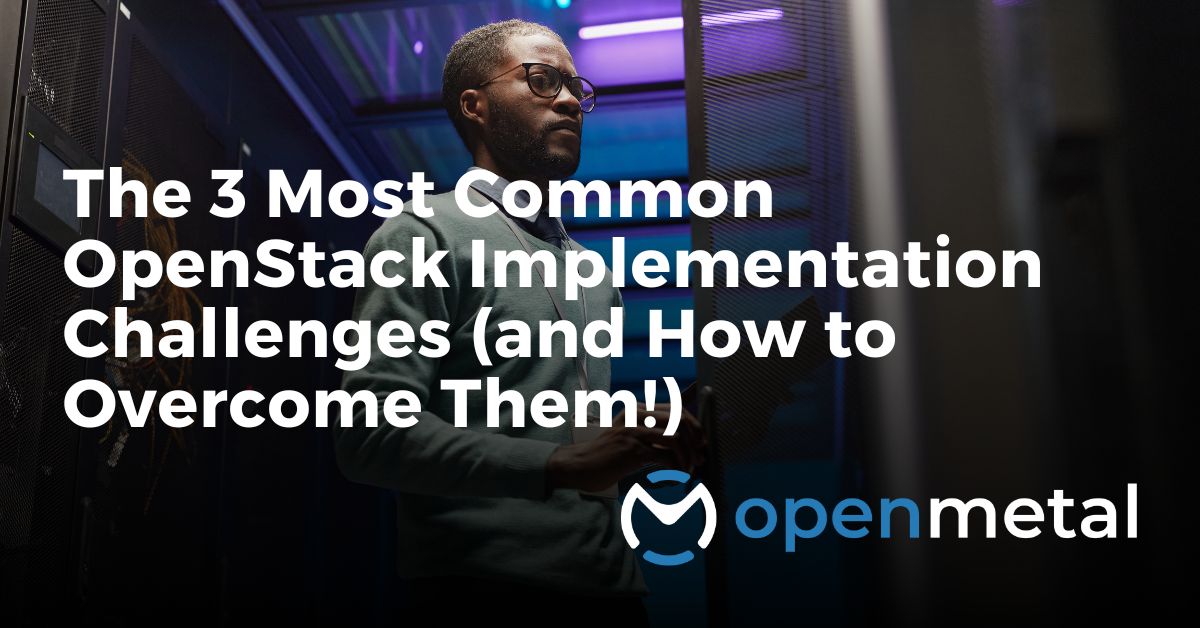OpenStack is gaining popularity among businesses seeking to efficiently manage their IT infrastructure and reduce dependency on the mega cloud providers. While its open source nature and adaptability offer immense benefits, some challenges can arise during its implementation.
In this blog post, we will discuss the most common challenges faced during OpenStack implementation and provide ideas to help you overcome them.
1) Lack of Expertise and Budget
One of the main challenges when implementing OpenStack is the need for technical expertise with the platform. OpenStack is a complex platform that requires a lot of technical knowledge to manage and maintain. If you don’t have the necessary expertise in-house, you’ll need to hire consultants or outsource the management of your OpenStack environment.
Even within a skilled technical group, most will not have experience with OpenStack. In order to effectively learn to run a private cloud, the IT team has to convince the company to finance a “Pilot Program” for the potential cloud. Currently, those clouds can cost hundreds of thousands of dollars in server and network gear, plus 3-12 months’ worth of development time. And with that, many, maybe even the majority of the pilots never turn into a production cloud. Most companies can’t afford this waste of time and money!
To address the expertise and budget gap, consider the following potential solutions:
- Hire consultants. There are many companies that specialize in OpenStack consulting. They can help you design, implement, and manage your OpenStack environment. You’ll save your team’s time and reduce spend by avoiding setup mistakes from the start.
- Attend training. There are many training courses available on OpenStack. These courses can help you or your IT team learn the skills you need to implement and manage OpenStack. Check out our education hub for a great place to start learning.
- Join a community. There are many online communities where you can connect with other OpenStack users. These communities can provide you with support and advice. Check out the official OpenStack Contributor Community and the r/OpenStack subreddit to start.
- Use a managed service. There are a number of companies that offer fully- or partly-managed OpenStack services. These companies can help with day-to-day management of your OpenStack environment, so you don’t have to. While initially this seems like an expensive option, the hours you’ll save setting up, learning, managing, troubleshooting, and deploying OpenStack can easily make it worthwhile.
- Find a partner program. Some providers offer partner programs to provide onboarding support to your business and allow you to offer OpenStack services to your customers, too. (What a coincidence – OpenMetal has partner programs for SaaS companies, hosting and cloud providers, and other businesses that rely on cloud!)
- Use an on-demand OpenStack provider. Of course, I have to shout out our own service! Cost and expertise barriers are a huge reason OpenMetal was founded. We created our on-demand OpenStack platform to make it more accessible and affordable to all. You can have a validated, ready for production OpenStack cloud deployed in just 45 seconds, without having to invest in expensive infrastructure. It starts with a hyper-converged 3 server cluster and can be used on a daily basis for under $20/day. Try it out for free to see if it might be the right fit for your organization.
2) Lack of Standardization
Another frequent OpenStack implementation challenge is the lack of standardization. OpenStack is an open source platform, which means that there is no single vendor or set of vendors that provides support and services. This can make it difficult to find the right resources and support for your environment.
To mitigate this issue, follow these recommendations:
- Use a commercial distribution. Commercial distributions of OpenStack are often more stable and have more features than the upstream version. They also typically come with support from the vendor.
- Use a cloud management platform. A cloud management platform can help you manage your OpenStack environment more easily. It can also provide you with features such as monitoring, alerting, and reporting.
- Use a service provider. A service provider can offer you a managed OpenStack environment. This means that the provider will take care of the day-to-day management of your OpenStack environment, so you don’t have to.
- Contribute to OpenStack. If you’re comfortable with coding, you can contribute to OpenStack yourself. This can help you get the features you need and make OpenStack more stable.
3) Platform Maturity and Stability Concerns
OpenStack is constantly evolving, which can sometimes lead to unexpected issues. To prevent these concerns from affecting your business operations, it’s important to plan and strategize accordingly:
- Do your research. Before you deploy OpenStack, make sure you understand the platform and its potential risks. This includes understanding the security implications of using an open source platform, as well as the potential for downtime and other technical issues. Carefully evaluate your current infrastructure and software compatibility with OpenStack to identify potential problems before implementation.
- Plan for contingencies. Have a plan in place for how you will deal with problems, such as bugs or outages. This could include having a backup plan in place, or having a team of experts on call who can help you troubleshoot problems.
- Monitor your environment. Make sure you have a system in place for monitoring your OpenStack environment so that you can identify and fix problems quickly. This could include using a cloud management platform, or setting up your own monitoring system.
- Back up your data. Always have a backup of your data so that you can restore it if something goes wrong. This is especially important if you are using OpenStack for critical business applications.
- Use a managed or hosted service. A managed service provider can take care of the day-to-day management of your OpenStack environment, so you don’t have to. This can free up your time and resources, and it can also give you peace of mind knowing that your environment is being properly managed. A fully managed solution will always be the most expensive option since it’s the most convenient; if you have a competent IT team that just needs some extra support, a hosted service may be a more cost-effective choice.
- Contribute to OpenStack. If you’re comfortable with coding, you can contribute to OpenStack yourself. This can help you get the features you need and make OpenStack more stable.
Wrapping Up: Tackling Common OpenStack Implementation Challenges and Finding Solutions
While OpenStack implementation introduces certain challenges, careful planning and strategizing can help you to successfully overcome them.
How does OpenMetal help solve these common challenges? We created our on-demand OpenStack platform to make OpenStack more accessible to all. You can have a validated, ready for production OpenStack cloud deployed in just 45 seconds, without having to invest in expensive infrastructure. It starts with a hyper-converged 3 server cluster and can be used on a daily basis for under $20/day. Try it out for free to see if it might be the right fit for your organization.
By addressing the expertise gap, standardization issues, and contingency planning for platform maturity concerns, you can successfully deploy OpenStack and reap the benefits of this powerful and flexible cloud platform.
More on the OpenMetal Blog…

OpenStack Tutorial for Beginners
In this blog:
- Definition of OpenStack
- Agenda of OpenStack YouTube Tutorial
- How to Use Request a Cloud Trial to Use Along with the Tutorial
- Watch the Video Tutorial

Why is On-Demand OpenStack Important for SMBs?
In this blog:
- Why Build a Low-Cost, On-Demand OpenStack Private Cloud?
- Why is it Important for SMBs to be a part of the OpenStack, Open Source Community?
- Can this help other organizations like Universities or Governments?
- Why is OpenStack not in more common use by SMBs or similar organizations?
- OpenMetal’s Open Source Commitment

Matching Public Cloud Offerings with OpenStack
In this blog:
- Database as a Service (DBaaS)
- Functions as a Service (FaaS)
- Object Storage
- Do Your Due Diligence
Test Drive
For eligible organizations, individuals, and Open Source Partners, Private Cloud Cores are free to trial. Apply today to qualify.
Subscribe
Join our community! Subscribe to our newsletter to get the latest company news, product releases, updates from partners, and more.



































